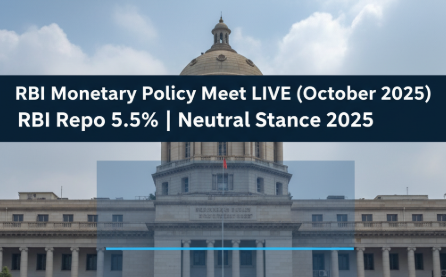- Sector -2, B Block Noida-201301
- info@tradingshastra.com
RBI Monetary Policy Meet LIVE — Repo 5.5% & Monetary Stance 'Neutral' (2025)

Why the RBI Monetary Policy Meet LIVE matters
RBI Monetary Policy Meet LIVE coverage is closely watched by borrowers, banks, markets and policymakers. The repo rate is the central lending rate that sets borrowing costs across the economy — from home loans to corporate credit. A hold at 5.50% signals the RBI’s cautious approach as it balances inflation control and growth support.
Markets react immediately — bond yields, banking stocks and interest-sensitive sectors change pricing in real time. That’s why understanding the RBI statement and the Governor’s press conference matters for investors and consumers alike.
Key decisions from the RBI Monetary Policy Meet LIVE
1. Repo rate held at 5.50%
The Monetary Policy Committee (MPC) decided to keep the policy repo rate unchanged at 5.50%. This follows earlier easing earlier in the year and reflects RBI’s view that inflation risks have moderated while growth is resilient.
2. Monetary policy stance: neutral
RBI kept the stance as neutral — meaning the central bank is not explicitly leaning towards easing (dovish) nor tightening (hawkish). A neutral stance signals that future rate moves will be data dependent: if inflation stabilizes RBI may ease; if inflationary pressures re-emerge RBI could tighten again.
3. Growth & inflation forecasts (updated)
- GDP (FY26): RBI revised its growth forecast up to 6.8% from prior 6.5% — signalling stronger domestic momentum.
- Inflation (FY26): RBI cited a lower path for consumer-price inflation — around 2.6% — reflecting softening food and core pressures.
4. SDF / MSF / corridor rates retained
Key standing rates remain aligned with the repo corridor:
- SDF (Standing Deposit Facility): 5.25%
- MSF / Bank Rate: 5.75%
5. Liquidity framework shift — WACR as anchor
RBI signalled an operational shift: using the Weighted Average Call Rate (WACR) as an operational anchor and focusing on 7-day liquidity operations rather than the earlier 14-day repos. This change aims to improve liquidity fine-tuning and keep the overnight rate close to the policy rate.
Quick take — What the decision signals
In short: repo 5.50% + neutral stance is a balanced policy outcome. RBI sees growth improving and inflation easing slightly. The bank remains data-driven — expect policy to respond to inflation prints and growth signals. The liquidity management change (WACR focus) is a technical but important move that affects short-term money markets and bank funding costs.
Note: This is a live-style summary. Further details and the Governor's press remarks (Q&A) will clarify nuance — watch the full MPC statement and official Q&A for implementation specifics and timelines.
Market Reactions After the RBI Monetary Policy Meet LIVE
Immediately after the announcement, Indian markets reflected the cautious optimism of the RBI decision:
- Bond yields: 10-year G-sec yields eased slightly to around 6.92%, reflecting confidence that inflation is under control.
- Bank stocks: PSU bank stocks corrected up to 1.5% as traders booked profits, while private banks remained stable.
- Equities: The Nifty Bank index traded flat, indicating that the hold decision was largely expected and already priced in.
- Rupee: INR showed marginal strength against the USD as global risk appetite improved and inflation forecasts were cut.
This mix shows markets were relieved there was no hawkish surprise, but also cautious about global volatility ahead.
Impact on Borrowers and Lenders
For everyday consumers, the RBI decision matters because it affects EMIs, deposits and investment returns:
- Home loans & EMIs: With repo unchanged, lending rates are unlikely to change immediately. Borrowers continue with current EMIs.
- Fixed deposits: Deposit rates remain attractive as banks continue to compete for liquidity.
- Corporate borrowing: Companies benefit from stable rates, encouraging investment and credit expansion.
Neutral stance also reassures borrowers that there will be no immediate hike shock, while investors get clarity that future cuts are conditional on inflation stability.
Risks and Forward Outlook
While today’s decision is balanced, risks remain:
- Global headwinds: Oil price spikes and US Federal Reserve tightening could limit RBI’s flexibility.
- Rupee depreciation: Continued weakness could import inflation and force RBI to defend stability.
- Monsoon impact: Agricultural output shocks could add pressure to food inflation.
For now, RBI expects inflation to trend lower, but remains ready to act if global or domestic risks push prices up.
FAQs — RBI Monetary Policy Meet LIVE
What is the current repo rate?
The repo rate remains at 5.50% as of October 2025.
What does “neutral stance” mean?
Neutral stance means RBI is not biased towards cutting or hiking rates. Future actions will depend on inflation and growth data.
How does this affect home loan EMIs?
EMIs are unlikely to change immediately as banks adjust rates only after repo changes. Current EMIs remain stable.
What is RBI’s inflation and growth forecast?
Inflation projected at 2.6% for FY26, GDP growth revised upward to 6.8% — signalling confidence in domestic growth.
When is the next RBI Monetary Policy Meet?
The next MPC meeting is scheduled for December 2025, where policy will again be reviewed based on updated inflation and growth data.
📊 Want to learn how monetary policy impacts trading? Read our detailed guide: Commodity Trading Time India 2025

